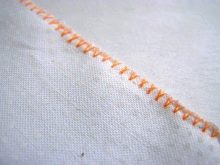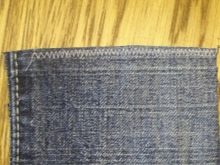Types of seams on the sewing machine and their application

Modern sewing is unthinkable without dozens of types and varieties of all kinds of seams. If you are not a simple tailor for whom hemming clothes is a harsh necessity and saving money on buying new clothes, then this variety is your way to sewing creativity.


Types of seams
There are dozens of types of worker and decorative strings used in sewing. The most common are straight (regular) and zigzag seams. However, a modern electronic sewing machine is capable of making any of the following stitches (except for a simple zigzag and straight seam without features):
- left-shifted straight line;
- right straight;
- quilting (resembles hand sewing);
- elastic for "grooving" knitwear;
- triple elastic fixing straight;
- 5 types of stitching lines;
- zigzag three-step for knitwear and "broken";
- satin and triple knitted zigzag;
- "Home", "double", knitted and "thin" overlocks;
- hidden bottom seams for elastic and rough fabric;
- patchwork lines;
- double and triple herringbones.
Worthy to crown this list 41 kinds of pretentious stitching.



Secret
Blind stitching refers to the type of stitching that makes the stitching of fabric layers invisible. Invisibility is necessary on the front sides of products, be it a dress or a soft toy, so as not to spoil their appearance. Blind seams are hidden between several pieces of sewn fabric. Beginners can practice on scraps: this line is such that not everyone will be able to execute it flawlessly the first time. It is used in the lower part of a product made of fine fabric (cotton, chintz, linen, etc.). Sewing trousers is an example.


Overcast
The purpose of the overcast seam is retention of the threads from which the fabric is woven, in order to prevent their divergence. Without such a line, the edges of the fabric would quickly turn into an unattractive fringe. Manual stitching is called buttonhole. However, a typewriter will complete such a line tens and even hundreds of times faster than a person manually. In mechanized sewing, the overcast seam is one of several looped.
Overcast stitching is best done on an electronically controlled typewriter.
You just need to select one of the modes, thread in the correct threads corresponding to the thickness of the fabric to be sewn, and you are ready to start sewing. An example is wrapping around button loops, cut under additional buttons, and neatly stitching the loose material on the side of jeans or a jacket.



Decorative
The more original varieties are referred to decorative stitches. Most often, they do not sew fabrics, but serve as embroidery, like repeating fragments in the shape of a herringbone, spikelet, flower, leaves, etc.
Sewing decorative seams requires high quality synthetic threads. If you use, for example, cotton threads, the stitched seams quickly wear off, begin to tear, and the material sewn with any of these seams (or a single layer of fabric stitched in the form of a pattern) will lose its original appearance. It is important that the machine is optimally tuned - skipping stitches is absolutely unacceptable here, as well as distortions. A factory garment or accessory made with not fully tuned or out of tune equipment will simply be returned by the buyer to the seller as defective.
A decorative seam is applied mainly to the extra edge of the fabric, one or several centimeters wide, turning it into a fashionable attribute. A well-made and neat seam is capable of even from roughly cut and torn material to make a masterpiece. An example of such an execution is a pocket sewn on the outside, a sewn bow or some kind of pattern in a conspicuous place. An alternative is the embroidery of letters, initials, inscriptions, for example, on the back of a sweatshirt or windbreaker. An example of such a seam is the butt variety, which is in demand in knitwear. This type is based on a zigzag stitch.

Elastic
The sewing machine must support sewing of the elastic seam. Make sure that it has such a mode. The area of application of the elastic seam is several of its varieties, which make it possible to sew, for example, double-sided windbreakers from membrane fabric. Such seams include: sewing, patch and superscript, French (including a variation of this seam for drape products), stitching, topstitching, two-sided special (it includes stitching and secret), and several other types.
The main requirement for elastic seams is the ability to work at some stretch, which excludes a sudden rupture of the product, where they run.
For elastic seams, the same threads are used, which have smoothness and the ability to stretch at least a little.
Attempts to sew elastic seams with coarse threads often result in rapid wear and tear on the garment or accessory on which such stitching was used.

Double
The double seam looks from the front side - a regular stitch. Its name speaks for itself. On the non-front side, it appears as a narrowed joint. The double seam itself is the next step in the development of a simple... It is used in an area where excessively protruding or, conversely, retracted sections of the parts to be sewn are completely absent. A double seam cannot be curved - it is performed only in the form of a straight line.But the advantage of such a seam overrides its disadvantage (limited use - only in straight sections): a double line is much stronger to break than a single straight line. Examples of using:
- production of pillowcases and duvet covers;
- embedding of internal pockets in all kinds of pants and shorts;
- trimming long sleeves with cuffs, etc .;
- sewing translucent peignoirs and other sexy lingerie;
- processing of thin and easily blooming material.
The double seam is also suitable for modernization, expanding the functionality of accessories - for example, sewing on additional inner pockets in ladies' and shopping bags.



Flat
For flat stitching, you will most likely need flattener. This is a sewing machine that has flat line blending modes. Flat sewing stitches are completely different from most of the simpler and more familiar ones used by novice tailors. Compared to overcast seams, it is laid in a completely different way. The number of needles is 2 or 3, resulting in a double and triple string, respectively. From the inside, it is intertwined completely, from the outside it looks like a simple seam with equal stitches sewn with one thread on each of the lines. The use of a flat line began precisely with knitwear, but today any fabric will do: the delicacy and precision of the “flat” sewing technology has been honed to perfection. An example is a flat seam on sweatpants, shorts, T-shirt, overalls, or sweatshirt.
For sewing with a flat seam at home, spools with one side are used, and in the factory, bobbins that resemble an inverted bucket are used. "Coverstitch" thread should be thin, but strong enough, slightly stretchable. The multi-needle machine must be carefully calibrated: a sudden change in the tension of one of the threads will lead to the fact that their weaving together will deteriorate, and the productivity and quality of your work will immediately drop dramatically.


Designation on typewriters
The designation of each of the modes of sewing matter on any machine is so simple and clear that even a beginner will get used to its control, having studied the theory and tried to sew something with his own hand, turning his knowledge into practical skills. For example, zigzag stitches look like serrated symbols. But the zigzag should be distinguished from the edge seam markers, which vaguely resemble the mathematical square root icon with a raised "mustache".
Simple seam - dotted line. The number of such lines indicates the multiplicity of the stitching (double, triple, multiple - depends on the number of simultaneously working needles).
Buttonhole (overcast) stitches are designated as a shape (for example, a rectangle) of parallel strokes.
The selected stitching mode will immediately be embodied in practice from the designation on the machine selector into exactly the same execution of the real stitch.


Application
The work of a seamstress began with a simple seam in time immemorial. Anyone who knows how to work at least in a simple way with a needle or a sewing stapler can manually make an even seam. Further, overcasting was added to simple seams - its first use was associated with giving buttonholes and garter loops a finished, neat look. Zigzag, and many simple seams are also easy to make by hand, but for very busy people a sewing machine will always come to the rescue.
The zigzag string is an "advanced" option for wrapping and decorating products. More complex seams, including pretentious ones, are an occupation for craftsmen who have long and sincerely been passionate about sewing and embroidery.



The types of stitches on the sewing machine can be seen in the video below.








